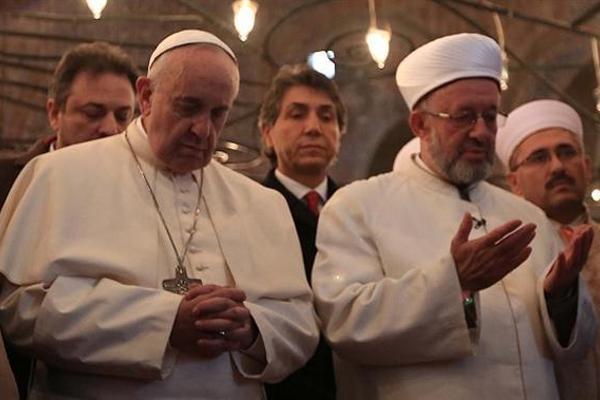Pope's first day in Istanbul boosts hopes of 'unification'
ISTANBUL


AA photo
Like his predecessor, Pope Francis "prayed" at the Blue Mosque, which was his first stop in Istanbul on Nov. 29 in the second leg of a richly symbolic three-day visit to Turkey, before boosting hopes of those who support the unification of the Roman Catholic Church and the Greek Orthodox Patriarchate.The pope was welcomed by Turkish authorities and Greek Orthodox Patriarch Bartholomew I at Atatürk Airport at 10.29 a.m. on Nov 29. “Your Holiness, beloved brother in Christ, we welcome you with great joy, esteem and love. Blessed is he who comes in the name of the Lord,” said Bartholomew I on greeting the pope.
Pope Francis first went to the Sultan Ahmet mosque, known as the Blue Mosque, one of the greatest masterpieces of Ottoman architecture.
When his predecessor Benedict XVI visited the mosque in 2006, he assumed the Muslim attitude of prayer and turned toward Mecca in what many saw as a stunning gesture of reconciliation. The Vatican later made clear he had not actually prayed in the mosque but was "in meditation."
After Rahmi Yaran, the mufti of Istanbul, briefed him on the history of the mosque and quoted the Quranic verses about the life of Mother Mary, Pope Francis asked if he could pray in a gesture reminiscent of his predecessor. The two religious figures then prayed together, facing Mecca, in what a Vatican spokesman described as a joint "moment of silent adoration" of God.
A group of school children waving Turkish and Vatican flags chanted "Long live Pope Francis" in Italian as the Muslim call to prayer rang out across Sultanahmet Square, the heart of Istanbul's historic quarter.
"We must show respect for each others beliefs. God willing the pope's visit will help in this respect," said Halil Ibrahim Cil, 24, a hospital worker from Istanbul. "We want to practice our religion in peace. We want people to understand Islam. We don't want war."
Next stops: Hagia Sophia, two churches, Patriarchate
The pontiff then went to the nearby Hagia Sophia Museum, originally built as an Eastern Orthodox cathedral in the sixth century before being converted into a mosque after the Ottoman conquest in 1453.
Hayrullah Cengiz, the director of the museum, briefed Pope Francis about the history of the Hagia Sophia. "I always enjoy telling about this section," Cengiz told the pontiff at one point, stressing the importance of a part of the building where centuries-old Christian mosaics can be seen side by side with the historical Islamic writings.
After writing in the notebook of the museum, the pope left Hagia Sophia without praying, as the Islamic call of prayer from the speakers of nearby mosques was heard in the historic building.
Pope Francis' original schedule had listed the Hagia Sophia as the first stop, but it was changed at the last moment.
Later in the day, the leader of the world’s Roman Catholics went to the Catholic Cathedral of the Holy Spirit in Istanbul for holy mass. A joyful crowd welcomed the pontiff, cheering "Viva Papa."
Doğan News Agency's Rome correspondent Esma Çakır shared a photo, showing the moment Pope Francis kissed the altar of the cathedral.
The pope's next stop was the Orthodox Patriarchal Church of St. George. The prayer at the church was followed by a private meeting with Greek Orthodox Patriarch Bartholomew I.
"I ask you to do me a favor: Bless me, and the Church of Rome," the Catholic News Agency quoted the pope as saying to the patriarch.
"The patriarch kissed the head of the pope. Officials say that this is a sign of respect from the Orthodox Patriarchate to the Church of Rome," DHA correspondent Çakır said, stressing that this gesture is perceived as "a strong message for the unification of the two Churches."
Narrowing differences between two Churches
Pope Francis will celebrate a private Mass on Nov. 30, followed by a divine liturgy and the signing of a joint declaration with Bartholomew.
Francis and Bartholomew -- who enjoy warm relations -- will seek to narrow the differences between the two churches that date back to the great schism of 1054.
"We are eagerly awaiting the visit of our brother, Pope Francis," Bartholomew had said ahead of the visit. "It will be yet another significant step in our positive relations as sister churches."
Turkey’s own Christian community is tiny -- just 80,000 in a country of some 75 million Muslims -- but also extremely mixed, consisting of Armenians, Greek Orthodox, Franco-Levantines, Syriac Orthodox and Chaldeans.
Of these only the small Franco-Levantine and Chaldean communities regard the pope as the head of their churches.
The pope held talks with Turkish President Recep Tayyip Erdoğan in Ankara on Nov. 28, calling for dialogue between faiths to end the Islamist extremism plaguing the Middle East.
The pope’s visit is seen as a crucial test of his ability to build bridges between faiths amid the rampage by Islamic State of Iraq and the Levant (ISIL) jihadists in Iraq and Syria and concerns over the persecution of Christian minorities in the Middle East.
"Inter-religious and inter-cultural dialogue can make an important contribution... so that there will be an end to all forms of fundamentalism and terrorism," he said.
Erdoğan -- who welcomed Pope Francis as the first foreign dignitary to his controversial new presidential palace outside Ankara -- for his part issued a strong warning about rising Islamophobia in the world.
"Islamophobia is rising seriously and rapidly. We must work together against the threats weighing on our planet -- intolerance, racism and discrimination," said Erdoğan.
Some 7,000 police will reportedly be on hand to supervise the pope’s two-day visit to Istanbul. Amid heavy security, he was not expected to show the close contact with crowds that have been such a feature of his past trips.
